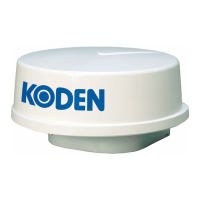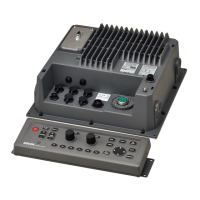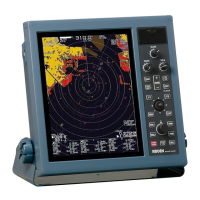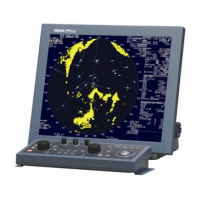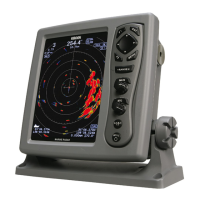Do you have a question about the Koden MDC-2000 series and is the answer not in the manual?
Explains the meaning of symbols used in the manual for user guidance.
Details safety precautions related to specific equipment components and their handling.
Provides safety guidelines for handling the radar unit and its components, including electromagnetic disturbance.
Provides instructions or guidelines for the proper disposal of the radar unit.
Lists standard and optional equipment included with the radar system, detailing specifications.
Describes different antenna models, their specifications, and associated cables.
Details a list of optional accessories available for the radar system, including their types and cable lengths.
Explains how to interpret the information displayed on the radar screen, including various indicators and symbols.
Describes the function and operation of each key on the control panel for user interaction.
Details the procedure for turning the radar unit on and off, including initial startup sequences.
Explains how to adjust the brightness of the LCD and control panel for optimal visibility.
Describes the process of starting and stopping the radar transmission, including STBY mode.
Explains how to change the observation range of the radar display for different viewing distances.
Details how to adjust the radar gain to optimize target visibility based on distance and environmental conditions.
Explains how to adjust the STC (Sensitivity Time Control) to suppress sea clutter and improve target visibility.
Describes how to assign and use functions to the F1 and F2 keys for quick access to features.
Explains how to temporarily delete the heading line from the radar display for better target visibility.
Describes how to use the crosshair cursor to indicate position, distance, and bearing on the radar screen.
Details the procedure for measuring distances and bearings between specific points on the radar display.
Explains how to connect and display video from a CCD camera on the radar screen.
Guides users on navigating and operating the radar's menu system for various settings.
Explains how to adjust the FTC (Fast Time Constant) to reduce rain or snow clutter for better target visibility.
Describes how to set different display modes (e.g., Head Up, North Up) for optimal radar image presentation.
Explains how to select different radar display configurations like PPI, PPI/PPI, and PPI/NAV.
Details how to adjust the display's center position to focus on specific areas of the radar screen.
Explains how to enlarge targets on the radar display to improve visibility of small objects.
Describes how to stabilize target signals for clearer and more reliable target display.
Explains how to select pulse widths for optimal target resolution or gain based on distance.
Describes how to enable and configure target trails to visualize the movement of targets over time.
Details how to use the Electronic Bearing Line (EBL) to measure bearings to targets.
Explains how to use the Variable Range Marker (VRM) to measure distances to targets.
Describes how to change the display color settings for improved visibility in different environmental conditions.
Explains how to change the shape of the crosshair cursor for better usability.
Describes how to use Parallel Index lines for navigation and target tracking.
Explains how to set the bearing display mode (True or Relative) for the crosshair cursor and EBL.
Describes how to display vectors representing the heading and speed of own ship and other targets.
Explains how to set and manage radar alarms for target detection and proximity warnings.
Describes the sleep mode function, which saves power by alternating transmit and standby states.
Details how to display and interpret information from the AIS (Automatic Identification System) receiver.
Explains the ATA (Automatic Tracking) function for tracking multiple targets and their movements.
Guides users on how to access and navigate the main system menu for configuration.
Explains how to set various assist items to enhance the radar's effectiveness and usability.
Describes how to set and use range rings for measuring distances on the radar display.
Explains how to set the preferred unit of distance for range and VRM measurements.
Details how to set the preferred unit of speed for displaying ship information.
Explains how to set the unit for water temperature display.
Details how to set the unit for water depth display.
Explains how to configure the display of position information (own ship, WPT, POB).
Describes how to set the display of the WPT (Waypoint) icon on the radar screen.
Guides on how to adjust the radar image bearing to match the ship's compass bearing.
Explains how to precisely match the radar target distance with the actual target distance by adjusting transmission delay.
Details how to adjust MBS (Minimum Bandwidth Suppression) to cancel disc-like transmission leaks.
Describes how to adjust the STC curve based on antenna installation height to optimize sea surface reflection.
Explains how to select between automatic and manual tuning for optimal transmission frequency.
Describes how to use interference rejection to eliminate noise from other radars.
Details how to configure NMEA settings, including transmission speed for external input/output.
Explains how to customize radar settings through presets, including key assignments and color settings.
Allows selection of functions to be assigned to the F1 and F2 keys for quick access.
Explains how to select the language for the menu interface.
Describes how to set the content displayed on the NAV display when in PPI/NAV mode.
Details regular monthly checks and cleaning procedures for maintaining the radar equipment.
Outlines annual inspection tasks, including checking antenna drive motor brushes for wear.
Explains the procedure for replacing fuses, emphasizing the use of specified fuse types.
Discusses consumable parts like the magnetron and when they might need replacement.
Provides guidance on troubleshooting common radar problems and information needed for repair requests.
Explains how to interpret error messages and alarms displayed on the radar screen.
Describes the built-in self-diagnostic capabilities for checking the radar's operational status.
Lists common trouble conditions and their suspected causes and countermeasures for systematic inspection.
Provides detailed instructions on selecting the optimal location and installing the radar antenna.
Explains methods to adjust antenna position to avoid blind spots caused by obstacles.
Guides on the physical installation of the antenna, including mounting on brackets or masts.
Specific instructions for installing radome-type antennas, including hole preparation and fixing.
Details the installation procedure for open antenna types, including orientation and mounting.
Provides step-by-step instructions for connecting antenna cables to the display unit.
Illustrates the wiring and color codes for connecting the antenna and display unit components.
Explains how to install the display unit on a desktop or flush-mount, including safety distance considerations.
Specific steps for mounting the display unit on a desk or flat surface.
Detailed instructions for installing the display unit into a panel or bulkhead.
Outlines essential adjustments to be performed after the display unit and antenna are installed.
Covers cable connections for power, antenna, and optional equipment to the display unit.
Details the pin assignments for various connectors on the rear of the display unit.
Explains how to connect the DC power cable and grounding for the radar system.
Guides on connecting external buzzers or monitors to the display unit.
Details how to connect an AIS receiver to the radar system for target information.
Explains how to connect navigation equipment and GPS sensors using NMEA ports.
Guides on connecting a CCD camera to the radar display unit.
Lists NMEA sentences that can be received and transmitted by the radar system.
Provides a hierarchical overview of the radar's menu structure and available settings.
Lists detailed technical specifications for the radar system, including antenna and display unit.
Shows dimensional drawings and external views of the radar display unit.
Explains the basic principles and functionality of a radar system as a navigation device.
Explains the concept of side lobes in radar antennas and their effect on performance.
Defines antenna beam width and its importance for radar resolution.
Discusses targets that provide weak reflections and how they are displayed or missed by the radar.
Explains the phenomenon of radar shadow caused by obstacles and how it affects target detection.
Describes various types of false images that can appear on the radar display and their causes.
| Transmitter Frequency | 9410 MHz ± 30 MHz (X-band) |
|---|---|
| Operating Temperature | -15°C to +55°C |
| Antenna Rotation Speed | 24 rpm |
| Azimuth Resolution | 2.5° |
| Range Scales | 0.25, 0.5, 0.75, 1.5, 3, 6, 12, 24, 48 nm |
